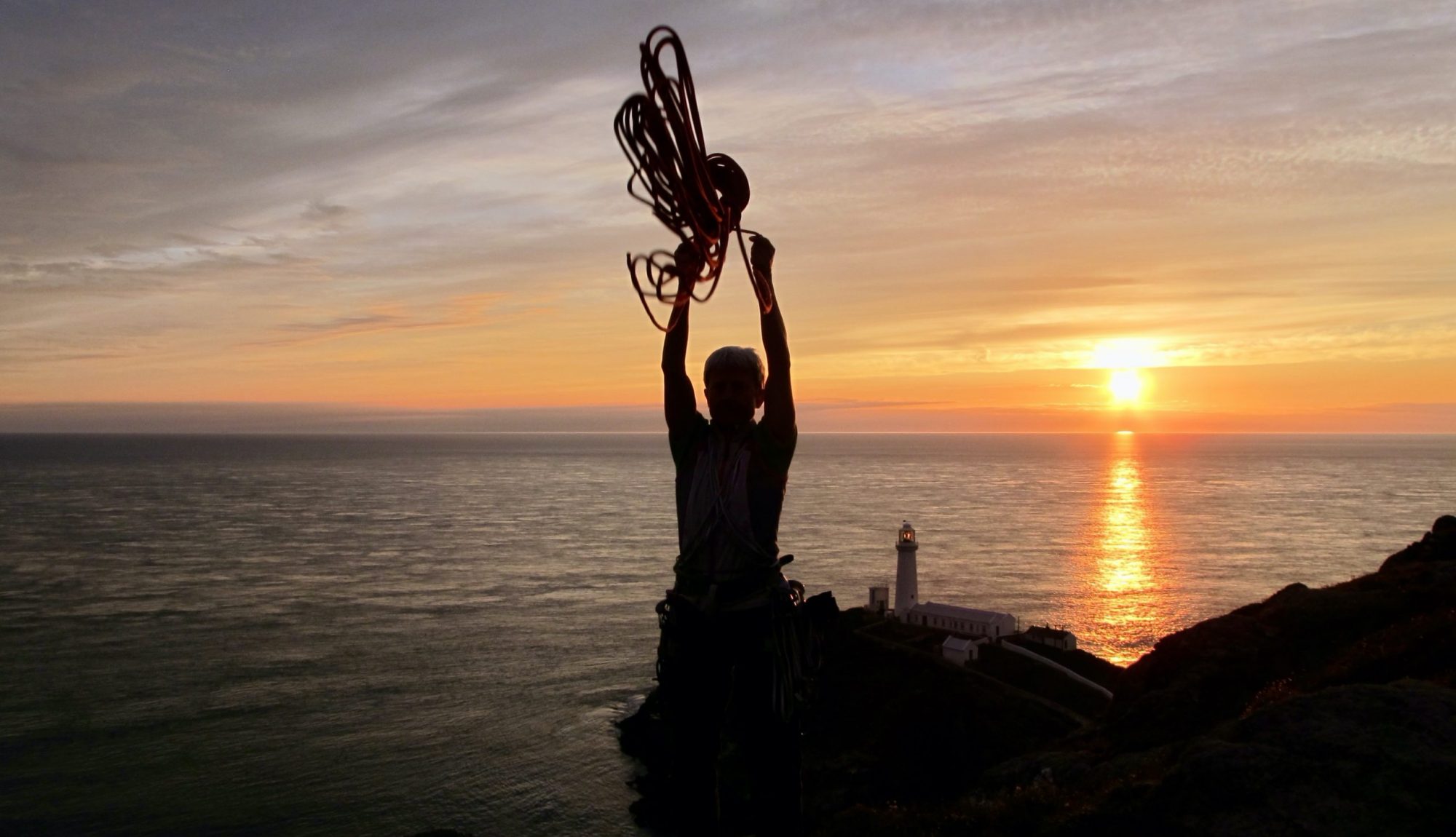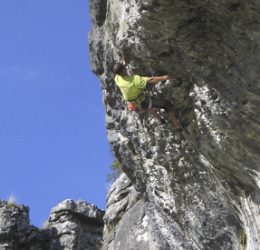This is the definitive sport climbing guide to La Hermida Gorge by Richie Patterson.
El Desfiladero de La Hermida is the definitive sport climbing guide to La Hermida gorge which straddles the Asturias/Cantabria border in NW Spain. It contains 24 never before published crags and nearly 700 routes, many of which have only recently been developed. The whole gorge from Pechon on the coast, to the alpine meadows of Cabanes, has a fantastic variety of single pitch sport climbing on generally excellent limestone. The routes are graded from very easy, on many accessible roadside slabs, to almost impossible up in the “almost inaccessible” world class cave of Carcalosa. This valley is covered by the second edition of the Roca Verde guide but the El Desfiladero de La Hermida guide has even more sectors included. A generous percentage from sales of the Roca Verde guide have funded some of the more recent development. The secrets of the most sought after crags in the valley, including the world-class venue of Cicera, are now described in detail. Clear photodiagrams are complemented by some excellent action photography. There is certainly something here for everyone at whatever grade you climb. A 70m rope should be considered a minimum but some of the newer hard routes advise a 100m rope as preferable, 20 quick draws will be enough for most of the routes covered in this guide.
The Climbing The crags are all situated on the Eastern flank of the Picos de Europa in or close to La Hermida gorge which straddles the border of Cantabria and Asturias in Northern Spain. The area is less than an hours drive from the airport and ferry terminals at Santander. There are 24 crags described in detail in this definitive guide to the area, many for the first time, the highlights include Rumenes, El Infierno, Cicera and Carcalosa. One or two of the sectors still have some trad climbs so be sure to read the guide carefully and/or carry a small rack of gear. There are many classic multi pitch mountain routes in the nearby Picos de Europa to enjoy but they are not covered by this guidebook.
The first crag described here is the sea cliff at Pechon with easy access and unique atmosphere for the area. Both sectors are slightly overhanging with a good selection of routes 6a-8a. Belen 6a and Jandro cotizando 6a are popular easier routes then there is loads of choice at 7a-7b but La vieja escuela 7a+ and Kurt Albert 7b are very enjoyable.
Estraguena is a small crag but packed with quality, south-east facing with plenty of afternoon shade. It is almost roadside but not really family friendly due to the awkward approach and the narrow ledge at it’s base. The crag offers a great introduction to tufa climbing in the valley and is generously graded, making it a good starting point. Princesa deva 7a, Marabunta 7a+, Alpinista Egoista 7a+, Granma 7c, Goliath 7c, Imperfectus bultus 7b+ and Austurcantabra 7c+ all standout. Primera intencion 7b is also good but I thought it was hard for the grade.
A short way further up the valley are Rumenes and nearby El infierno, they are among the best crags in the gorge with long and steep tufa climbing especially in the 7’s and with some 8a classics. They both get plenty of shade in the afternoon.
Probably the most sought after routes at Rumenes are the outstanding Invocando de Onan 7a and the unrelenting 40m pump fest Sindrome de Stendhal 8a. However Vinarock 7a+, Rumenes power y albino 7a+, Apokalimnos 7b, Tubular hell 7b+, El dia del arquero 7c and Panico nuclear 7c are all exceptional. Some of the highlights up at El infierno include the steep and burly Malas Pulgas 7a, Hellboy 7a+, Cachimente 7b, Balambambu 7c, El algoritmo Wallman 8a and the brilliant 47 ronin 8a.
The next crag of note is the accessible Urdon with a selection of popular routes in the 6’s and 7’s and three good 8a’s. El pajaro momificado is an enjoyable 6b with a harder extension at 7a. Effecto Domino 7band the unnamed 7c to its left are both very good. Vias y mujeres 8a is a relatively new route that has already reached classic status. The car park is large, however this is also the starting point for a very popular walk so all the parking spots can be taken up very early in the day.
A short way further up the road is another south facing crag which enjoys the sun until about 4pm. This is the accessible El Salmon with many routes at more reasonable grades. The photo ticks here are El polivaliente 6b and El retorno de mechas 7a.
Cueva del Ribero, Sector Clonica and Cueva del Corazon are three popular crags close to the village of La Hermida. Rebelion en la granja 7a, Chucho’s Wall 7b and Estira la Parra 7b+ all standout. The recently developed Cueva Hermida, a pleasant 20m walk from the village centre, is crammed full of steep powerful routes for the strongest climbers. There are also many smaller quieter venues worth checking out as you progress up the gorge. Parelosa is shady with good routes in the high 7’s that would benefit from more traffic. One of the best routes is Relatividad 7c+ however the photo tick is La coquilla asesina 8a which is a 15m extension of Perirrojo 7b. Dolce Galbana 8a+ is a spectacular 26m route, with three distinct cruxes, that is rapidly becoming a power endurance classic.
Valle de Bajes is a side valley rising out from La Hermida towards the village of Bajes, which is a popular starting point for walks up into the Picos de Europa and is also well known for it’s speciality cheeses. The Bajes valley also contains a few accessible crags which are ideal for novices. The quick drying crag Calabreru is more difficult to access and the belays are off narrow ledges. The wall is gently overhanging, the routes are hard and up to 40m long. The photo tick here is Eowyn 7c+.
Cicera is 15 minutes pleasant stroll followed by 5-10 minutes steeply uphill. This north facing venue provides plenty of shade and it’s needed because the route are hard. Lots of 7’s and 8’s to try up here. Pacifis 7b+ and Mancha roja 7c are both hard but remain justifiably popular. Deambulante was overgraded at 8a but the climbing is good so it should remain popular as a hard 7c+. The excellent Troncomovil 8a has a tricky diedre to negotiate then an endurance fight to the top. If you prefer tufa endurance then Veneno azul 8a is considered a classic. Walking on the Moon 8a+ is a hard and technical test piece, the superb Arte si quieres 8a+ is also worth checking out. For 40m of pure resistance try Entropia and Treinta anos de locura 8b, both are superb. At a more reasonable grade La Corbata de Unquera 7a is well worth doing but possibly not the best choice for a warm-up. Steep and intense at the start, then technical face climbing higher up. The next route right Naturaleza Viva 7a+ is also a popular route on some curious iron intrusions.
If that’s all a bit too easy, on the opposite side of the gorge you will find Carcalosa. An aerobic 45 minutes of scrambling steeply up, occasionally pulling on ropes, leads to the huge cave with routes up to 9a and harder projects. The right side is a bit more amenable with the classic Dimensiones paralelas 7c+ tackling the twin tufa system.
There are some more smaller river side sectors to check out as you travel further up the gorge including Placas de Esquilleu. This has a slab that is very popular with novices. Nearby is El Lado Oscuro (The Dark Side) and if you are willing to wade the river you will be rewarded with some long routes at 7c and three at 8’s. The excellent Museo Coconut 7c and Gretaline 8a+ are both over 30m long.
Cabanes comprises of six sectors with a good spread of grades that all overlook the stunning alpine meadows and enjoying spectacular views of the Picos de Europa.
The ancient town of Potes offers shops, cafes and restaurants making it an interesting day destination. La Reunion Bar in Potes is a great spot with good beer, music and wifi along with climbing info & topos. Posada La Cuadrona at La Hermida also has wifi and topos for some of the more secretive sectors.
Beyond Potes is the small sunny sector of Los Zaborros de los Llanos which is unusual in that it has steep easy routes, Vs and 6s, ideal for novices wanting to progress from slab climbing. Finally don’t miss the dozen or so gently overhanging pump fests ranging from 6b to 7b at the south facing Cosgaya up near the head of the valley.
Rest Day Activities
A superb way to relax on a rest day and recover from the powerful wrestling with the many steep tufa climbs in the area, is to enjoy the freely accessible hot springs situated underneath the bridge that leads to the Balneario Spa Hotel. There is no signage so it is very easy to miss despite being adjacent to the main road. Other activities could include hillwalking in the stunning mountains of the Picos de Europa, Via Ferrata, bike rides or the telepherique from Fuente De. Alternatively perhaps a trip out to the coast to surf or just sit on the beach.
Accommodation
There are ample places for climbers to sleep rough in a van. Camping la Viorna is a popular campsite near Potes, while there is almost too much choice if you prefer to be closer to the coast.










